
Rune Factory: Guardians of Azuma Review
If you'll spare me a moment of indulgence, I want to talk briefly about progression systems in RPGs. This ties into how I feel about Rune Factory: Guardians of Azuma, but if you're only here for the quick and dirty: it's a decent farming/village RPG with middling combat, lackluster dungeon design, an OK story, and a pretty good cast of characters. Throughout the game, you are teased and enticed by various progression systems that could have been great or engaging: a vast sky to soar around in, a gear system that has modular customization, and home decorations that provide passive stat bonuses. Scratch beneath the surface, though, and you find there is not a whole lot there after all. It's like Potential Man — if and when, but never is.
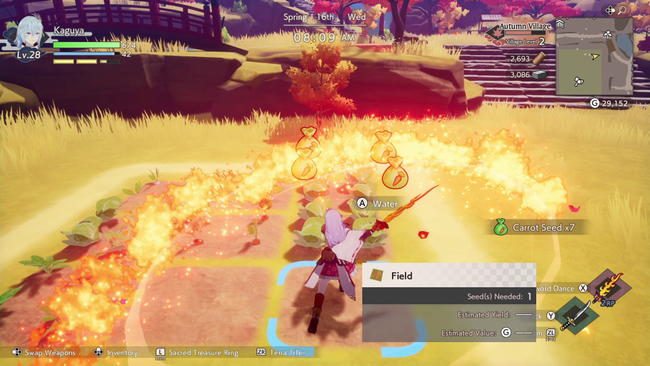
I generally tend to categorize RPGs by how they feel when you progress in them — an RPG with a middling narrative but great feeling progression can elevate the game tremendously. A great example of this, for me, would be Final Fantasy VIII. The story in FF8 isn't bad, but it wasn't grabbing me the way 7, 9, or 10 did. However, drawing and junctioning? Now that's my jam. Yes, you could snap the game over your knee if you knew what you were doing, but the fact that FF8's mechanics allow for that elevates FF8 into being an all-time "great" feeling game.
The inverse of this is Final Fantasy XVI, a game with such simple progression mechanics that it hinders the game considerably — a so-so story supplemented by a thin system where your god sword (forged from rare materials and possessing the power of an Eikon) can be upgraded by five points with something that — by the game's own admission — states that it "makes for a poor blade." Bland, frustrating feeling progression leaves a sour taste in my mouth.
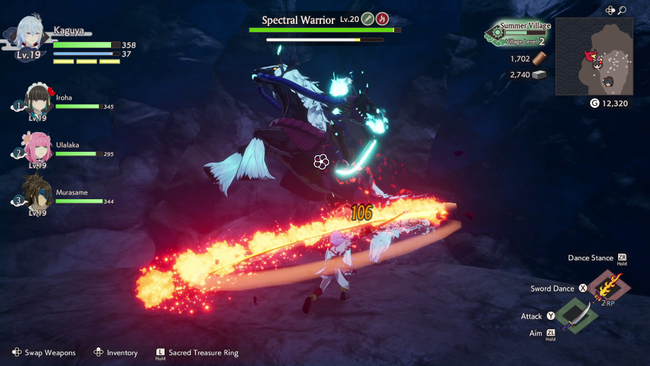
Which brings us to Rune Factory: Guardians of Azuma. While the game shows promise throughout, it's never fully realized. This was my first Rune Factory game, and I was assured by multiple people that I trust that if I liked sicko-mode mechanics, I'd really like Rune Factory 4. I didn't get a chance to play that, but I was excited to see what a modern take on Rune Factory felt like, and it turns out, it feels like Genshin Impact (but worse).
Guardians of Azuma plays almost exactly like Genshin Impact does. You don't have a stamina meter, but beyond that, the controls are basically one-for-one. You've got a dodge, you can run and jump, and your normal attacks are basic combos. You are later given access to several elemental "spells" (godly artifacts) that do exactly three things: a normal elemental attack, a stronger attack that requires one bar of meter, and an ultimate attack that requires two bars of meter and plays a cutscene.
However, the only thing these abilities do is damage, healing, or some minor battlefield effect (like gravity). That's it. You're hitting the enemy with their weakness to do bonus damage. This isn't by itself a bad thing, most RPGs do this in some capacity, but when your game so heavily resembles Genshin Impact, why not borrow their elemental interaction system? Make it so that when you burn enemies, you can create a fire tornado by hitting them with wind magic or something to spice up the combat a bit. Give me some interlocking pieces to fit together to create satisfying combinations of some sort. For an action RPG, the combat was very lackluster.
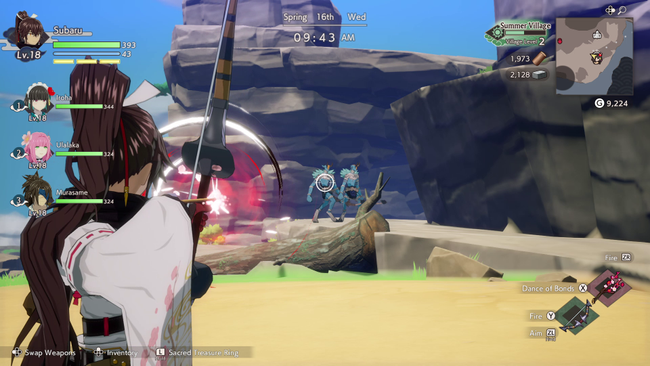
Lackluster combat can be supplemented by interesting systems elsewhere, however, so what about stat and gear customization? Gear customization exists in Guardians of Azuma, but as far as I'm aware, it's simply socketing gems (Magatama) into slots for benefits like +3 Strength or +3% Water Damage. Yippee. By contrast, I looked at a crafting guide for Rune Factory 4, where you could have items "inherit" traits from others, like increased range or status-inflicting abilities. That sounds really interesting and cool! If that feature exists in Guardians of Azuma, it was not anywhere in the main story — all I could do was forge gear, level it up, and give it gems.
You can grant yourself bonus stats via the village sim elements, such as +50 Strength from an Imp Statue, but with how many spaces you get to plop things down, it was very simple to set something and forget about it — almost no thinking or planning necessary. Speaking of stats, I couldn't tell you what certain stats do. Strength is easy to intuit, sure, but what does Mind do? I searched for a menu option to let me figure it out and went through every tutorial, and I couldn't find anything. I still don't know what the Mind stat does or how it affects my character. Some items that could be placed in your villages had tags, like a Wheelbarrow would have the tag "Farming Fun". Other items could have this tag too, so I assumed it was a category, but what does it do? Anything? Could I search this category and find similar items that I was missing? Not in any menu I looked at.
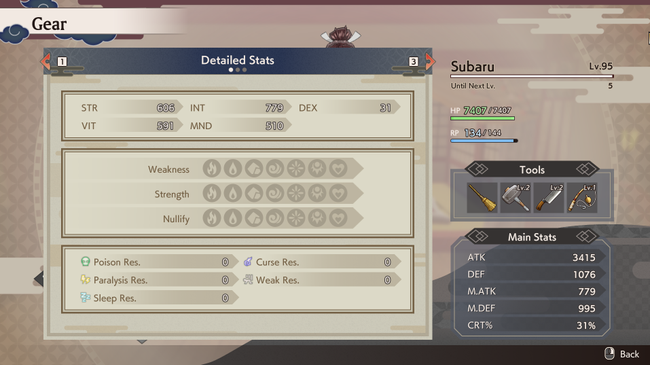
There is an astonishing lack of signposting in this game. If I can't find an option to figure out what my stats do, and I can't find a way to view item categories or see what the benefits are in your RPG, that is a problem. When I completed the game, I noticed that there were several warp slots left undiscovered, but I was certain I had explored the entire game world so far, which told me that there's significant post-game content to get to. However, I still cannot figure out how to trigger the post-game. When you complete the game, a pop-up arises saying "The adventure isn't over! Work on your bonds!"... and that's it. Does the game want me to max out every single bond? If so, I'll pass, because while I do love the cast of characters, I am not spending the obscene amount of hours required to max out 25 party members just to get to slightly more challenging but still bland combat content.
I decided to do another flyover of all the areas in the game to verify that I didn't miss something, and realized that I don't care for the overworld travel. How do you take the idea of riding a flying dragon and exploring splintered islands and make it tedious? By making you watch the same landing cutscene and forcing you to hold the skip button for a few seconds every time until you unlock the warp. Those islands don't have anything except nodes and fish, by the way — some islands do have dungeon portals on them, but they're all story-related, so you'll find them anyway by completing the story. There was no "hidden island" or "secret area" or anything special to discover, just empty islands full of weak monsters and mining nodes.
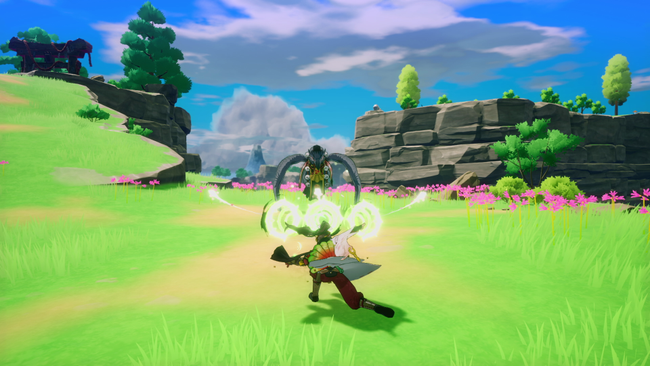
It was around this point that I was venting my frustrations in the RPG Site staff channel, and I was informed by multiple people that the post-game in other Rune Factories didn't unlock until you got married. So I went and did that...and nothing else happened aside from a second round of credits. No dungeons opened up, no cutscenes other than the marriage cutscene played, and I was left directionless aside from working on Bonds and raising Village levels. But the method of doing both of those things doesn't feel fun to do, so why would I?
The cast of characters is, admittedly, extremely good. Every anime trope you can think of is represented in some way — the hyperactive younger sister who's actually a profoundly good fighter, the wise, sagacious nerd who is extremely good at games, the wanna-be serious and squared-away boy who turns into an actual puppy when he gets too excited, the mommy, sorry, mommy, sorry, Calico Cat tavern keeper, the list goes on. I did enjoy my time with these characters, but not enough to suffer the frankly poor implementation of speaking to each and every one of them each and every day to level up relationships.
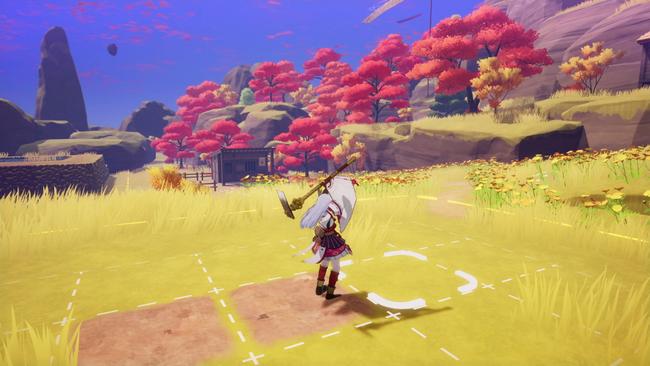
The aesthetic of the game is fine. I live in Japan and could immediately recognize, say, the Autumn Village taking inspiration from shrines around Kyoto, such as Kibune Shrine or Fushimi Inari Taisha. The village designs are fantastic...which leads me to ask why the dungeon designs are so boring? In order, your dungeons are: a canyon with grass and water, a cave with water, an (admittedly cool) clockwork ninja house, an ice cave with frozen water, an (admittedly cool) demon underworld city, and a holy shrine with water. Once you complete those dungeons the first time around, you get to do a second, slightly more challenging round of the same environments, but they still amount to hallways with the occasional group of enemies or the same Blight puzzle copy/pasted a hundred times over. Find the Blight node to clear the barrier to another Blight node to clear the final barrier blocking your progress.
However, something about the environments in general feels... off. I'm not an artist, and I cannot adequately put it into words, but everything feels "flat". Look at the screenshot below. There are some nice intricacies, but it overall just looks very flat and bland. This is a key location in the game! This is one of the four "bases" you visit with alarming regularity, and yet it feels unfinished somehow, even though it's not. I could be wrong on this because I don't have any art background to speak of, but it bothered me enough that I had to mention it.

Another issue I had with this game is the final dungeon of the main story. Let me set the scene (slight spoilers, but I will keep it vague). You are attempting to prevent the bad guys from resurrecting a fallen god who will destroy the world. The only way for people to reach the object that allows this is via a flying fortress platform armed with cannons. You have a flying dragon, however, so you can infiltrate the platform and dismantle it from within. This sounds cool, right? Battle your way inwards towards the platform's center to stop the big bad while the entire fortress soars through the air towards ultimate destruction.
The dungeon itself is extremely simply textured walls and floors with a cloudy sky, the occasional lighting strike in the distance, the same Oni enemies you've fought since level 5, and the same boring Blight puzzles that occasionally impede your progress for thirty minutes while you work your way towards the boss. No joke, when I hit the checkpoint, I fell asleep because of how bored I was. This is something that has never happened to me before: in the penultimate scenario of a game, a time when I'm supposed to be full steam ahead, ready to finish the fight, I fell asleep instead because I was bored out of my gourd.
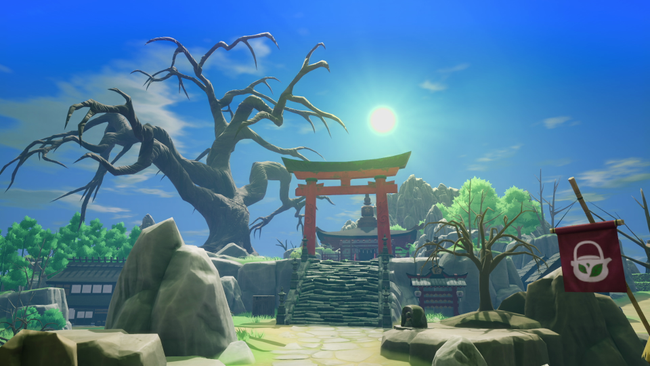
I thought about giving Guardians of Azuma a 7, because what game is here isn't strictly terrible, but unfortunately it is extremely disappointing on a wider scale. Boring dungeons, bland combat, lackluster progression, and thin customization are propped up by a fun cast of characters, pretty good voice acting, and pretty good village editing tools — but it's not enough to make the game fun to play. If you only care about the character interactions and marrying the love of your Azuma life, then the combat and village management is a tedious means towards that end, and if you're looking for engaging progression systems, you'll have to look elsewhere, I'm afraid.
Now if you'll excuse me, I'm going to go play Rune Factory 4 and get mad that everything I was looking for in Guardian of Azuma probably exists in that game already.